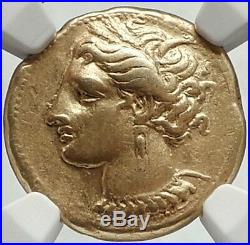
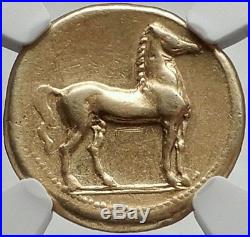
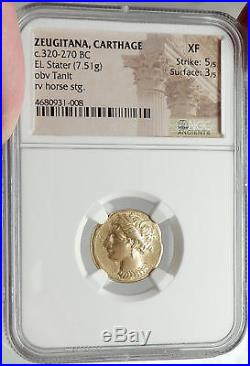
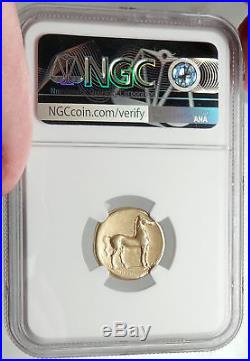
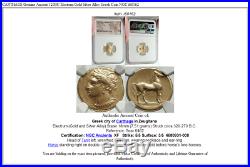

Item: i68162 Authentic Ancient Coin of. Greek city of Carthage. In Zeugitana Electrum (Gold and Silver Alloy) Stater 18mm (7.51 grams) Struck circa 320-270 B. Reference: Sear 6462 Certification: NGC Ancients. XF Strike: 5/5 Surface: 3/5 4680931-008 Head of Tanit. Left, wreathed with corn, wearing necklace and ear-ring. Standing right on double exergual line; pellet in lower field before horse’s fore-hooves. Tanit was a Phoenician lunar goddess, worshiped as the patron goddess at Carthage where from the fifth century BCE onwards her name is associated with that of Baal Hammon and she is given the epithet pene baal (“face of Baal”) and the title rabat , the female form of rab (chief) (Markoe 2000:130). Tanit and Baal Hammon were worshiped in Punic contexts in the Western Mediterranean, from Malta to Gades into Hellenistic times. In North Africa, where the inscriptions and material remains are more plentiful, she was, as well as a consort of Baal, a heavenly goddess of war, a virginal mother goddess and nurse, and, less specifically, a symbol of fertility. Several of the major Greek goddesses were identified with Tanit by the syncretic interpretatio graeca , which recognized as Greek deities in foreign guise the gods of most of the surrounding non-Hellene cultures. Her shrine excavated at Sarepta in southern Phoenicia revealed an inscription that identified her for the first time in her homeland and related her securely to the Phoenician goddess Astarte (Ishtar). One site where Tanit was uncovered is at Kerkouan, in the Cap Bon peninsula in Tunisia. The origins of Tanit are to be found in the pantheon of Ugarit, especially in the Ugaritic goddess Anat (Hvidberg-Hansen 1982), a consumer of blood and flesh. There is significant, albeit disputed, evidence, both archaeological and within ancient written sources (Markoe 2000:136), pointing towards child sacrifice forming part of the worship of Tanit and Baal Hammon. Tanit was also a goddess among the ancient Berber people. Her symbol, found on many ancient stone carvings, appears as a trapezoid/trapezium closed by a horizontal line at the top and surmounted in the middle by a circle: the horizontal arm was often terminated either by two short upright lines at right angles to it or by hooks. Later, the trapezoid/trapezium was frequently replaced by an isosceles triangle. The symbol is interpreted by Hvidberg-Hansen as a woman raising her hands. In Egyptian, her name means Land of Neith , Neith being a war goddess. In modern times the name, with the spelling “Tanith”, has been used as a female given name, both for real people and, more frequently, in occult fiction. Carthage (Arabic: Qarj , Ancient Greek: Karkhdn , Kartajen , Hebrew: kartago , Latin: Carthago or Karthago , from the Phoenician Qart-adat meaning New City , implying it was a’new Tyre’) refers to a series of cities on the Gulf of Tunis, from a Phoenician colony of the 1st millennium BCE to the current suburb outside Tunis, Tunisia. The first civilization that developed within the city’s sphere of influence is referred to as Punic (a form of the word “Phoenician”) or Carthaginian. The city of Carthage is located on the eastern side of Lake Tunis across from the centre of Tunis. According to Roman legend it was founded in 814 BCE by Phoenician colonists from Tyre under the leadership of Elissa (Queen Dido). It became a large and rich city and thus a major power in the Mediterranean. The resulting rivalry with Syracuse and Rome was accompanied by several wars with respective invasions of each other’s homeland. Hannibal’s invasion of Italy in the Second Punic War culminated in the Carthaginian victory at Cannae and led to a serious threat to the continuation of Roman rule over Italy; however, Carthage emerged from the conflict at its historical weakest. After the Third Punic War, the city was destroyed by the Romans in 146 BCE. However, the Romans refounded Carthage, which became one of the three most important cities of the Empire and the capital of the short-lived Vandal kingdom. It remained one of the most important Roman cities until the Muslim conquest when it was destroyed a second time in CE 698. The study of the history of Carthage is often problematic. Due to the subjugation of the civilization by the Romans at the end of the Third Punic War, very few Carthaginian historical primary sources survive. There are a few ancient translations of Punic texts into Greek and Latin, as well as inscriptions on monuments and buildings discovered in North Africa. However, the majority of available primary source material about Carthaginian civilization was written by Greek and Roman historians, such as Livy, Polybius, Appian, Cornelius Nepos, Silius Italicus, Plutarch, Dio Cassius, and Herodotus. These authors came from cultures which were nearly always in competition, and often in conflict, with Carthage. The Greeks contested with Carthage for Sicily, for instance, and the Romans fought the Punic Wars against Carthage. Inevitably the accounts of Carthage written by outsiders include significant bias. Recent excavation of ancient Carthaginian sites has brought much more primary material to light. Some of these finds contradict or confirm aspects of the traditional picture of Carthage, but much of the material is still ambiguous. Carthage was one of a number of Phoenician settlements in the western Mediterranean that was created to facilitate trade from the cities of Sidon, Tyre and others from Phoenicia, which was situated in the coast of what is now Syria, Lebanon and Israel. In the 10th century BC, the eastern Mediterranean shore was inhabited by various Semitic-speaking populations, who had built up flourishing civilizations. The people inhabiting what is now Lebanon called their language Canaanite, but were referred to as Phoenicians by the Greeks. The Phoenician language was very close to ancient Hebrew, to such a degree that the latter is often used as an aid in translation of Phoenician inscriptions. The Phoenician cities were highly dependent on both land- and seaborne trade and their cities included a number of major ports in the area. In order to provide a resting place for their merchant fleets, to maintain a Phoenician monopoly on an area’s natural resource, or to conduct trade on its own, the Phoenicians established numerous colonial cities along the coasts of the Mediterranean, stretching from Iberia to the Black Sea. They were stimulated to found their cities by a need for revitalizing trade in order to pay the tribute extracted from Tyre, Sidon, and Byblos by the succession of empires that ruled them and later by fear of complete Greek colonization of that part of the Mediterranean suitable for commerce. The initial Phoenician colonization took place during a time when other neighboring kingdoms (Greek, Hittite, Cretan) were suffering from a “Dark Age”, perhaps after the activities of the Sea Peoples. Carthage was founded by Phoenician settlers from the city of Tyre, who brought with them the city-god Melqart. Philistos of Syracuse dates the founding of Carthage to c. 1215 BC, while the Roman historian Appian dates the founding 50 years prior to the Trojan War i. Between 1244 and 1234 BC, according to the chronology of Eratosthenes. The Roman poet Virgil imagines that the city’s founding coincides with the end of the Trojan War. However, it is most likely that the city was founded sometime between 846 and 813 BC. World-renowned expert numismatist, enthusiast, author and dealer in authentic ancient Greek, ancient Roman, ancient Byzantine, world coins & more. Ilya Zlobin is an independent individual who has a passion for coin collecting, research and understanding the importance of the historical context and significance all coins and objects represent. Send me a message about this and I can update your invoice should you want this method. Getting your order to you, quickly and securely is a top priority and is taken seriously here. Great care is taken in packaging and mailing every item securely and quickly. What is a certificate of authenticity and what guarantees do you give that the item is authentic? You will be very happy with what you get with the COA; a professional presentation of the coin, with all of the relevant information and a picture of the coin you saw in the listing. Additionally, the coin is inside it’s own protective coin flip (holder), with a 2×2 inch description of the coin matching the individual number on the COA. Whether your goal is to collect or give the item as a gift, coins presented like this could be more prized and valued higher than items that were not given such care and attention to. When should I leave feedback? Please don’t leave any negative feedbacks, as it happens sometimes that people rush to leave feedback before letting sufficient time for their order to arrive. The matter of fact is that any issues can be resolved, as reputation is most important to me. My goal is to provide superior products and quality of service. How and where do I learn more about collecting ancient coins? Visit the “Guide on How to Use My Store”. For on an overview about using my store, with additional information and links to all other parts of my store which may include educational information on topics you are looking for. The item “CARTHAGE Genuine Ancient 320BC Electrum Gold Silver Alloy Greek Coin NGC i68162″ is in sale since Sunday, March 25, 2018. This item is in the category “Coins & Paper Money\Coins\ Ancient\Greek (450 BC-100 AD)”. The seller is “highrating_lowprice” and is located in Rego Park, New York. This item can be shipped worldwide.
- Culture: Greek
- Coin Type: Ancient
- Denomination: Stater
- Composition: Electrum (Gold and Silver Alloy)
- Era: Ancient Greece
- Material: Silver
- Certification: NGC
- Certification Number: 4680931-008
- Grade: XF

